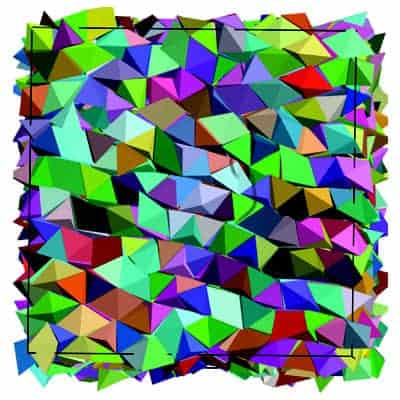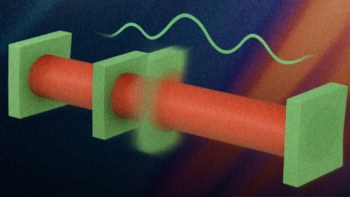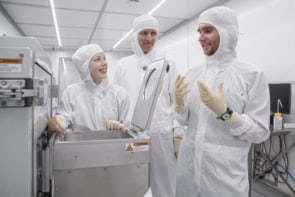
The colourful image shown right is an illustration of a new quasicrystal formation that has been discovered using computer simulations. The formation consists of hard triangular bipyramids, each composed of two regular tetrahedra sharing a single face, and is described in a paper in Physical Review Letters by Sharon Glotzer and colleagues at the University of Michigan in the US.
Prize-winning field
Quasicrystals – materials that have ordered but not periodic structures – were discovered by Daniel Shechtman in 1984 and won him the 2011 Nobel Prize for Chemistry.
Before Shechtman’s discovery, it was thought that long-range order in physical systems was impossible without periodicity. Atoms were believed to be packed inside crystals in symmetrical patterns that were repeated periodically over and over again. But Shechtman found atoms in a crystal that were packed in a pattern that could not be repeated and yet had “10-fold” rotational symmetry. Since then, hundreds of different quasicrystals have been discovered, including icosahedral quasicrystals that have 2-fold, 3-fold and 5-fold rotational symmetry. There are also octagonal (8-fold), decagonal (10-fold) and dodecagonal (12-fold) quasicrystals that exhibit “forbidden” rotational symmetries within 2D atomic layers but that are periodic in the direction perpendicular to these layers.
Complex configuration
In this new work, the researchers, using Monte Carlo simulations, have found a degenerate dodecagonal quasicrystal that is formed when the constituent particles are at packing fractions above 54%. This new formation is only the second quasicrystal formed with hard particles and the first one that is degenerate.
Here, “degenerate” means that there is no unique lowest energy ground state of the crystal system that corresponds to a single unique configuration of the atoms. “Instead, there are a large number of configurations of these hard triangular bipyramids with the same overall energy and so they are called degenerate,” explains physicist Rónán McGrath from the University of Liverpool in the UK, who has been studying quasicrystals for the past 12 years but was not involved in the work. The “hard particles”, McGrath goes on to explain are particles that are purely geometric – there are no attractive or repulsive interparticle interactions, as would be seen if the particles had atomic content. Glotzer’s group found a quasicrystal formation for hard tetrahedrals – the first of its kind – in 2009.
The team’s calculations also showed that for higher packing fractions, a triclinic crystal formation is preferred. “Imagine covering a table top with dominoes. There are many ways of completely covering the table with no space between the dominoes – you could either place all the dominoes horizontally, vertically or both ways. From the point of view of the two ‘lobes’ of the domino [the two sections], all arrangements are identical. However, if you draw lines connecting the two lobes within a single domino, then each arrangement looks different. This is precisely the case for our particles, which are like 3D tetrahedral ‘dominoes’,” explains Glotzer.
“I think this work is really interesting because it goes some way towards helping us understand why and how quasicrystals form – the biggest open question in the field – by looking at purely geometric effects,” says McGrath. According to Glotzer, the work highlighted the fact that entropy may play a much larger role in quasicrystal formation than was previously thought.
Historical path
McGrath also told physicsworld.com that he was intrigued by the new discovery as it follows in the tradition of the work carried out by Alan Mackay from the UK, who was one of the first to explore geometric effects in crystallography. “He was, in turn, a student of [pioneer crystallographer] John Bernal, who, in turn, was a protégé of the Lawrence Bragg; so for me, there is a nice linkage right back to the origins of crystallography.”
Over the years, quasicrystals have led to important discoveries in a variety of fields, from nanoscience to supramolecular chemistry. Photonic “metamaterials” based on quasicrystals may one day replace semiconductor devices in communication and information technologies, while quasiperiodic arrays of electronic spins could reveal new aspects of magnetism for spintronics and other “transformation optics” applications.



